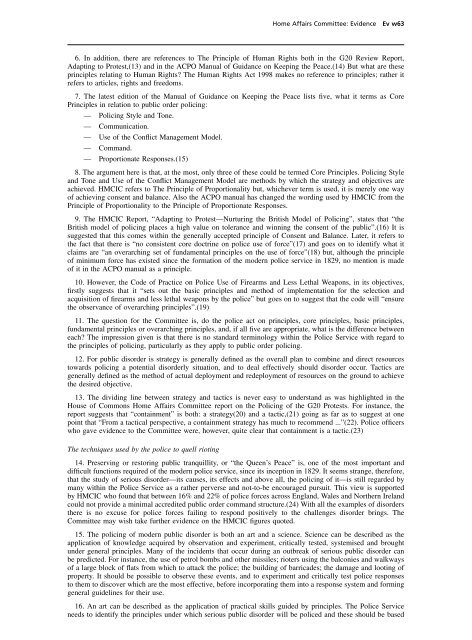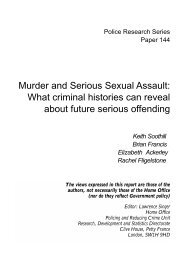Policing Large Scale Disorder: Lessons from the disturbances of ...
Policing Large Scale Disorder: Lessons from the disturbances of ...
Policing Large Scale Disorder: Lessons from the disturbances of ...
You also want an ePaper? Increase the reach of your titles
YUMPU automatically turns print PDFs into web optimized ePapers that Google loves.
Home Affairs Committee: Evidence Ev w63<br />
6. In addition, <strong>the</strong>re are references to The Principle <strong>of</strong> Human Rights both in <strong>the</strong> G20 Review Report,<br />
Adapting to Protest,(13) and in <strong>the</strong> ACPO Manual <strong>of</strong> Guidance on Keeping <strong>the</strong> Peace.(14) But what are <strong>the</strong>se<br />
principles relating to Human Rights? The Human Rights Act 1998 makes no reference to principles; ra<strong>the</strong>r it<br />
refers to articles, rights and freedoms.<br />
7. The latest edition <strong>of</strong> <strong>the</strong> Manual <strong>of</strong> Guidance on Keeping <strong>the</strong> Peace lists five, what it terms as Core<br />
Principles in relation to public order policing:<br />
— <strong>Policing</strong> Style and Tone.<br />
— Communication.<br />
— Use <strong>of</strong> <strong>the</strong> Conflict Management Model.<br />
— Command.<br />
— Proportionate Responses.(15)<br />
8. The argument here is that, at <strong>the</strong> most, only three <strong>of</strong> <strong>the</strong>se could be termed Core Principles. <strong>Policing</strong> Style<br />
and Tone and Use <strong>of</strong> <strong>the</strong> Conflict Management Model are methods by which <strong>the</strong> strategy and objectives are<br />
achieved. HMCIC refers to The Principle <strong>of</strong> Proportionality but, whichever term is used, it is merely one way<br />
<strong>of</strong> achieving consent and balance. Also <strong>the</strong> ACPO manual has changed <strong>the</strong> wording used by HMCIC <strong>from</strong> <strong>the</strong><br />
Principle <strong>of</strong> Proportionality to <strong>the</strong> Principle <strong>of</strong> Proportionate Responses.<br />
9. The HMCIC Report, “Adapting to Protest—Nurturing <strong>the</strong> British Model <strong>of</strong> <strong>Policing</strong>”, states that “<strong>the</strong><br />
British model <strong>of</strong> policing places a high value on tolerance and winning <strong>the</strong> consent <strong>of</strong> <strong>the</strong> public”.(16) It is<br />
suggested that this comes within <strong>the</strong> generally accepted principle <strong>of</strong> Consent and Balance. Later, it refers to<br />
<strong>the</strong> fact that <strong>the</strong>re is “no consistent core doctrine on police use <strong>of</strong> force”(17) and goes on to identify what it<br />
claims are “an overarching set <strong>of</strong> fundamental principles on <strong>the</strong> use <strong>of</strong> force”(18) but, although <strong>the</strong> principle<br />
<strong>of</strong> minimum force has existed since <strong>the</strong> formation <strong>of</strong> <strong>the</strong> modern police service in 1829, no mention is made<br />
<strong>of</strong> it in <strong>the</strong> ACPO manual as a principle.<br />
10. However, <strong>the</strong> Code <strong>of</strong> Practice on Police Use <strong>of</strong> Firearms and Less Lethal Weapons, in its objectives,<br />
firstly suggests that it “sets out <strong>the</strong> basic principles and method <strong>of</strong> implementation for <strong>the</strong> selection and<br />
acquisition <strong>of</strong> firearms and less lethal weapons by <strong>the</strong> police” but goes on to suggest that <strong>the</strong> code will “ensure<br />
<strong>the</strong> observance <strong>of</strong> overarching principles”.(19)<br />
11. The question for <strong>the</strong> Committee is, do <strong>the</strong> police act on principles, core principles, basic principles,<br />
fundamental principles or overarching principles, and, if all five are appropriate, what is <strong>the</strong> difference between<br />
each? The impression given is that <strong>the</strong>re is no standard terminology within <strong>the</strong> Police Service with regard to<br />
<strong>the</strong> principles <strong>of</strong> policing, particularly as <strong>the</strong>y apply to public order policing.<br />
12. For public disorder is strategy is generally defined as <strong>the</strong> overall plan to combine and direct resources<br />
towards policing a potential disorderly situation, and to deal effectively should disorder occur. Tactics are<br />
generally defined as <strong>the</strong> method <strong>of</strong> actual deployment and redeployment <strong>of</strong> resources on <strong>the</strong> ground to achieve<br />
<strong>the</strong> desired objective.<br />
13. The dividing line between strategy and tactics is never easy to understand as was highlighted in <strong>the</strong><br />
House <strong>of</strong> Commons Home Affairs Committee report on <strong>the</strong> <strong>Policing</strong> <strong>of</strong> <strong>the</strong> G20 Protests. For instance, <strong>the</strong><br />
report suggests that “containment” is both: a strategy(20) and a tactic,(21) going as far as to suggest at one<br />
point that “From a tactical perspective, a containment strategy has much to recommend ...”(22). Police <strong>of</strong>ficers<br />
who gave evidence to <strong>the</strong> Committee were, however, quite clear that containment is a tactic.(23)<br />
The techniques used by <strong>the</strong> police to quell rioting<br />
14. Preserving or restoring public tranquillity, or “<strong>the</strong> Queen’s Peace” is, one <strong>of</strong> <strong>the</strong> most important and<br />
difficult functions required <strong>of</strong> <strong>the</strong> modern police service, since its inception in 1829. It seems strange, <strong>the</strong>refore,<br />
that <strong>the</strong> study <strong>of</strong> serious disorder—its causes, its effects and above all, <strong>the</strong> policing <strong>of</strong> it—is still regarded by<br />
many within <strong>the</strong> Police Service as a ra<strong>the</strong>r perverse and not-to-be encouraged pursuit. This view is supported<br />
by HMCIC who found that between 16% and 22% <strong>of</strong> police forces across England, Wales and Nor<strong>the</strong>rn Ireland<br />
could not provide a minimal accredited public order command structure.(24) With all <strong>the</strong> examples <strong>of</strong> disorders<br />
<strong>the</strong>re is no excuse for police forces failing to respond positively to <strong>the</strong> challenges disorder brings. The<br />
Committee may wish take fur<strong>the</strong>r evidence on <strong>the</strong> HMCIC figures quoted.<br />
15. The policing <strong>of</strong> modern public disorder is both an art and a science. Science can be described as <strong>the</strong><br />
application <strong>of</strong> knowledge acquired by observation and experiment, critically tested, systemised and brought<br />
under general principles. Many <strong>of</strong> <strong>the</strong> incidents that occur during an outbreak <strong>of</strong> serious public disorder can<br />
be predicted. For instance, <strong>the</strong> use <strong>of</strong> petrol bombs and o<strong>the</strong>r missiles; rioters using <strong>the</strong> balconies and walkways<br />
<strong>of</strong> a large block <strong>of</strong> flats <strong>from</strong> which to attack <strong>the</strong> police; <strong>the</strong> building <strong>of</strong> barricades; <strong>the</strong> damage and looting <strong>of</strong><br />
property. It should be possible to observe <strong>the</strong>se events, and to experiment and critically test police responses<br />
to <strong>the</strong>m to discover which are <strong>the</strong> most effective, before incorporating <strong>the</strong>m into a response system and forming<br />
general guidelines for <strong>the</strong>ir use.<br />
16. An art can be described as <strong>the</strong> application <strong>of</strong> practical skills guided by principles. The Police Service<br />
needs to identify <strong>the</strong> principles under which serious public disorder will be policed and <strong>the</strong>se should be based
















